Most of us have heard of the term “Content Marketing” here and there over the past few decades, and have seen online marketers use it quite often. But what exactly do we mean? What do you understand by content marketing?
Content Marketing focuses on producing and disseminating worthwhile, pertinent, and consistent material in order to draw in and hold the attention of a target audience and ultimately encourage profitable consumer action.
The key to successful content marketing is understanding your audience and tailoring your content to their specific needs and preferences
Let’s step into the guide to learn more about how to create a content marketing strategy!
Table of Contents
- Why Content Marketing is Important
- The Step-by-Step Process
- Content Marketing Funnel
- Types of Content Marketing
- Tools for Measuring Effectiveness
Why is Content Marketing Important?
Content marketing aims to provide helpful information and resources to potential customers to build trust, establish authority, and foster a long-term relationship.
Benefits and importance of content marketing:
Building brand awareness:
Content marketing can help build brand awareness by creating valuable and current trending topics that resonates with your target audience. This can help establish your brand as a thought leader in your industry and increase your visibility.
Attracting and retaining customers:
By creating relevant and trending blog topics, you can attract potential customers to your website and keep them coming back for more. This can help establish a relationship with your audience and increase the chances of converting them into customers.
Improving search engine rankings:
By producing high-quality content that is optimised for search engines, you can improve your website’s search engine rankings. This can help drive more organic traffic to your site and increase your online visibility.
Establishing authority:
By creating content that is informative and helpful, you can establish your brand as an authority in your industry. This can help build trust with your audience and increase your credibility.
Overall, content marketing is an effective way to build brand awareness, attract and retain customers, improve search engine rankings, and establish authority in your industry.
The Step-by-Step Process
Content marketing is an effective way to attract and engage your target audience, build brand awareness, and ultimately drive sales.
A successful content marketing strategy is a fantastic approach to advertising your brand. And, ideally, you want to distinguish your company from the competition when they are ready to buy.

Here is the step-by-step process to help your content marketing business grow:
1. Define your target audience:
Understanding your target audience is key to creating content that resonates with them. You should consider factors such as age, gender, location, interests, and pain points.
Determine what you want to achieve through content marketing, such as
- building brand awareness,
- increasing website traffic,
- or generating leads.
2. Create high-quality content:
Your content should be well-written, informative, and engaging. Use a mix of formats such as blog posts, videos, podcasts, and infographics to keep your audience engaged.
Create content that is relevant and valuable to your target audience, and that aligns with your business goals. One should also make use of trending topics for Content Writing to increase
3. Consistent brand messaging:
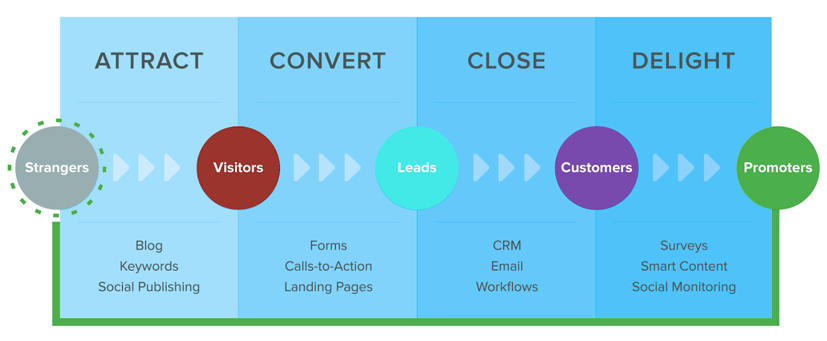
Develop a consistent brand voice and messaging across all your content channels.
Consistent brand messaging is an essential element of successful content marketing. It refers to the use of a unified voice, tone, and messaging across all content channels, to ensure that your brand is presented in a clear and cohesive manner to your target audience.
- Use consistent visual elements, such as your logo, colour scheme, and typography, across all your content channels, to reinforce your brand identity.
- Monitor and adjust: Continuously monitor your content channels and adjust your messaging as needed, based on feedback and performance data.
4. Use SEO to increase visibility:
Use relevant keywords in your content to improve your website’s search engine ranking. This will make it easier for your target audience to find you.
5. Leverage social media:
Share your content on social media platforms to increase its reach. Engage with your audience by responding to comments and messages.
Create content that is relevant and valuable to your target audience, and that aligns with your business goals.
Plan your content in advance and create a calendar to ensure consistency. This will help you stay organized and ensure that your content aligns with your business goals.
6. Measure and analyse:
Track your content performance using analytics tools to see what’s working and what’s not. Use this information to optimize your content strategy and improve your ROI.
Establish metrics for measuring the success of your content marketing efforts, such as website traffic, engagement, lead generation, and sales.
Content Marketing Funnel
A lot of the stuff we access online serves one very clear purpose: to persuade you to make a purchase and also, register or discover more.
Even seemingly light hearted articles like “The Top Best Dog-Friendly Cafes in Delhi” have been carefully written to elicit a particular reaction.

This is because of the fact that the majority of the information we read and interact with on a daily basis is a product of the content marketing funnel.
Find out more about this content funnel and the many content marketing strategies in the following section!
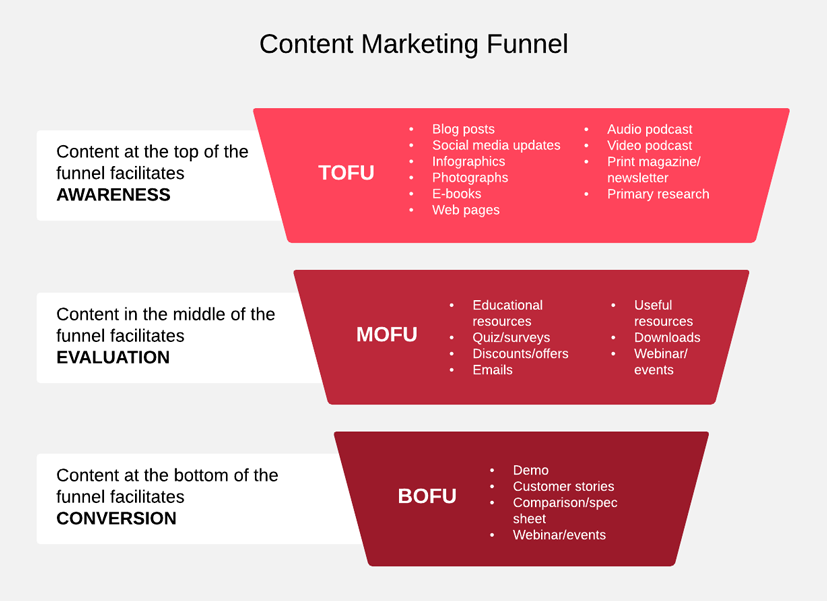
The content marketing funnel is a framework that outlines the different stages of a buyer’s journey, from initial awareness of a problem or needs to the final purchase decision.
The funnel comprises four stages:
1. Awareness:
At the top of the funnel, the goal is to attract the attention of potential customers and make them aware of your brand and offerings.
In this stage, your audience is typically not yet aware of the problem or need that your product or service can solve.
This can be achieved through various content types,
- blog posts,
- social media content,
- and videos.
The ultimate goal of the Awareness stage is to create a connection with your target audience and establish your brand as a trusted authority in your industry.
2. Interest:
In this phase, potential customers are actively researching and seeking out more information about their problems or needs. You should understand what’s trending so that your content can be designed to provide valuable information and address their pain points.
Examples of content that can be used in the Interest stage include:
- blog posts,
- articles,
- videos,
- webinars,
- white papers,
- case studies, and
- product demos.
The content should be informative, engaging, and relevant to the customer’s interests and needs.
3. Consideration:
At this stage, potential customers have narrowed down their options and are actively considering your brand as a solution.
The goal is to provide information that helps the customer make an informed decision in consideration to what is trending right now and positioning the brand as the best choice for their needs.
Examples of content that can be used in the Consideration stage include
- product comparisons,
- customer reviews and testimonials,
- case studies,
- pricing and
- feature guides.
4. Decision:
In the final stage, potential customers are ready to make a purchase decision. Your content should provide clear calls to action and make it easy for them to take the next steps, such as signing up for a free trial or purchasing.
Examples of content that can be used in the Decision stage include
- product demos,
- free trials,
- case studies,
- testimonials, and
- special offers or promotions.
Types of Content Marketing
The primary goal of content marketing is to build relationships with your target audience by providing them with valuable, informative, and entertaining content. One should also do a thorough market research to understand the trending searches today. By doing so, you can establish yourself or your brand as a trusted authority in your industry, which can lead to increased brand awareness, customer loyalty, and sales.
There are several content marketing types, each with its own unique purpose and format.
Here are some of the most common types of content marketing:
1. Blogging:
Blogging is the one of the most common types of content marketing types, which involves writing informative and engaging blog posts to attract and engage a target audience.
When readers find your blog’s content useful, they’ll link to certain blog posts and build up your organic backlink profile. These advantages will increase your ranking and, thus, your visibility.
You may evaluate the success of your blog using a number of measures. Select the metrics that most accurately represent the goals you have for your writing.
- Traffic rates: See how many people are reading your blog and compare the number of new and returning visitors to learn more about readership and loyalty.
- Check out the site’s activities to see what visitors do after reading a post. Are they clicking on other people? Do they browse the remainder of your website? Or did they simply quit your website?
- Estimate the number of blog readers who eventually convert to leads and subsequently customers.
- How frequently and from which sources do your blog entries receive backlinks?
- How does your blogging affect the Share of Voice of your company?
The ideal length of a blog post can vary depending on the topic, target audience, and the goals of the blogger. Generally, a good blog post should be long enough to provide value and fulfill its purpose, while also being concise and engaging enough to hold the reader’s attention.
There is no hard and fast rule on the length of a blog post, but many experts suggest that a post should be at least 300 words in length to be considered a proper blog post. However, longer posts tend to perform better in search engines and have higher engagement rates, so a blog post of around 1000-2000 words is often recommended.
2. Infographics:
Infographics are visual representations of information and data designed to communicate complex ideas in a clear and engaging way.
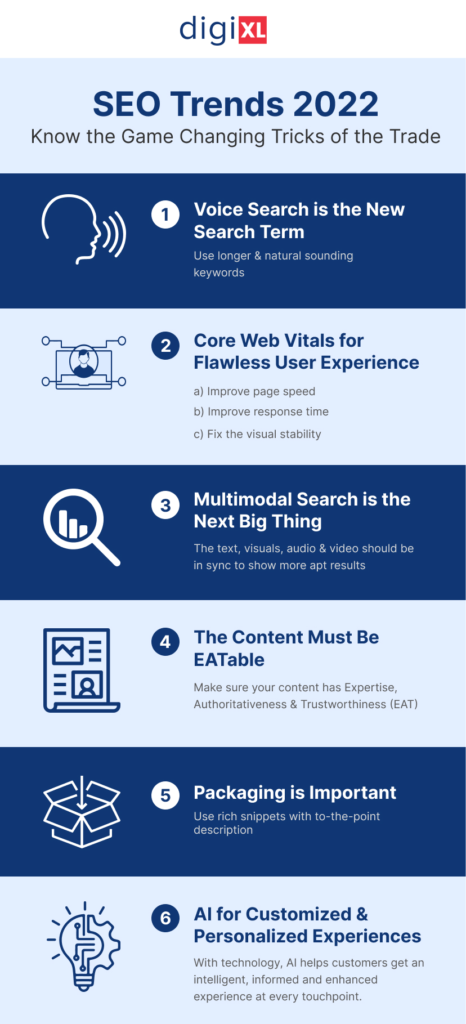
They are a great way to share statistics, research findings, and other data-driven insights.
The creation of a successful content marketing strategy is the objective of every content marketer.
- Designing exceptional visual material for use on various social media platforms or the occasional blog post is one method to do this.
- Infographics can be helpful in this situation, especially when it comes to converting challenging data into interesting content marketing pieces.
- To captivate people, even a straightforward infographic in vibrant colours, like this one, would be quite effective.
3. Video Marketing:
Videos are an increasingly popular types of content marketing. They can be used to tell a brand’s story, showcase a product or service, or provide educational content.
More than any other type of content, 54% of audiences want to watch videos from brands they support, according to HubSpot research.
Videos can be shared on social media platforms, embedded on websites, or used in email marketing campaigns.
Building a video as a content marketing strategy involves several key steps. Here is a general overview of the process:
- Identify your target audience: Before creating a video, it’s important to understand who your target audience is and what kind of video content will resonate with them.
- Define your goals: Determine what you want to achieve with your video content. Do you want to raise brand awareness, drive website traffic, or increase sales? Your goals will help shape the content and messaging of your video.
- Develop a concept: Brainstorm ideas for your video, considering the format, tone, and messaging that will appeal to your target audience. You may want to create a storyboard or script to help visualize your concept.
- Produce your video: Once you have a concept, it’s time to produce your video. This may involve hiring a production company or using in-house resources to shoot and edit your video.
- Optimize for distribution: After creating your video, optimize it for distribution. This may involve adding captions, optimizing for SEO, and promoting it on social media and other channels.
- Measure results: Monitor the performance of your video to see if it’s meeting your goals. Analyze metrics such as views, engagement, and conversions to assess the effectiveness of your video and make improvements for future content.
By following these steps, you can build a video as a content marketing strategy that engages your target audience, supports your goals, and drives results for your business.
4. Email Marketing:
Email is a powerful type of content marketing strategy that businesses can use to build relationships with their target audience and drive conversions.
Here are some ways that email can be used as a content marketing strategy:
- Email newsletters: Companies can create regular newsletters that provide their subscribers with updates on company news, industry insights, and helpful resources.
- Promotional emails: Businesses can use promotional emails to offer discounts, announce new products or services, or promote sales.
- Drip campaigns: Drip campaigns are a series of automated emails that are sent to subscribers over a set period of time.
- Event invitations: Companies can use email to invite subscribers to attend events, such as webinars or live events.
5. Social media content:
Social media content is a content marketing type that involves creating and sharing content on social media platforms such as Facebook, Twitter, and Instagram. Such social media platforms can prove to be a great content marketing platform for your business.
This content can include text, images, videos, and infographics, and can be used to engage with customers and build brand awareness.
Here are some ways that social media can be used as a content marketing tool:
- Build brand awareness: Social media platforms like Facebook, Twitter, and Instagram provide businesses with a way to reach a large audience and build brand awareness. By creating and sharing engaging content, businesses can increase their visibility and grow their social media following. They also need to be aware of what is popular right now!
- Establish thought leadership: it can be used to showcase a business’s expertise and establish thought leadership in their industry. By sharing valuable content that educates and informs their target audience, businesses can build credibility and trust with their followers.
- Drive traffic to your website: it can be used to drive traffic to a business’s website. By sharing links to blog posts, landing pages, and other content, businesses can encourage their followers to visit their websites and learn more about their products or services.
- Engage with customers: it provides businesses with a way to engage with their customers and build relationships. By responding to comments and messages, businesses can show their customers that they care and value their feedback.
- Repurpose content: it can be used to repurpose existing content into new formats. For example, businesses can turn blog posts into social media posts, infographics, or videos, extending the life of their content and reaching a wider audience.
6. E-books:

E-books are an effective form of content marketing strategy that businesses can use to attract and engage their target audience.
Here are some reasons why e-books are a great content marketing tool:
- Demonstrate expertise: By creating an e-book on a topic related to your business, you can showcase your expertise and establish yourself as a thought leader in your industry.
- Provide value: they are a great way to provide valuable information to your audience. By providing high-quality content that educates and informs your audience, you can build trust and credibility with them.
- Generate leads: they can be used as a lead generation tool. By offering your e-book as a free download in exchange for contact information, you can generate leads and build your email list.
- Increase website traffic: they can be promoted on your website and social media channels, driving traffic to your website and increasing your online visibility.
- Repurpose content: they can also be repurposed into other forms of content such as blog posts, social media posts, and infographics, extending the life of your content and reaching a wider audience.
7. Case Studies:
Case studies are a powerful form of content marketing strategy that can help businesses showcase their expertise and establish credibility with their target audience.
A case study is an in-depth analysis of a particular situation or problem, often detailing how a business helped a customer overcome a challenge or achieve a goal.
This LinkedIn case study offers a thorough examination of how Adobe uses LinkedIn to promote its brand and attract candidates. It details Adobe’s marketing with data and screenshots and shows how the company gauged its effectiveness with the workplace platform.
Buyers may examine a customer’s journey from beginning to end and similar use cases in action by using case studies.
8. Podcasts:
Podcasts are a form of audio content marketing that involves creating and sharing audio content on a particular topic.
They can be used to share industry insights, provide educational content, or showcase a brand’s personality and voice.

Even if it’s difficult to build a large audience unless you’re a comedian, podcast content marketing could be an effective way to reach a particular audience with a diversity of thoughts and information.
With an email address connected to your podcast, customers and potential customers can leave direct comments on the content.
Then you can create a new episode to reply to queries or comments. Comments are available on many podcast hosting and gathering websites. You may use that feedback to create fresh podcast content for content marketing.
9. Meme Marketing:
Memes are highly shareable, and they spread quickly through social media channels, making them an ideal way for brands to increase their reach and engagement.
When creating memes, brands should also consider the platform they will be sharing them on. Different social media platforms have different audiences and preferences for content.
For example, memes on Twitter tend to be more text-based and sarcastic, while memes on Instagram tend to be more visual, and focused on pop culture references
A clever technique to boost traffic is to properly schedule a meme and connect it with your social aesthetic and what is trending now such as popular series, old-school movie references or quirky advertisements
10. Testimonials and Customer Reviews:
Testimonials and customer reviews can be a powerful form of content marketing technique for businesses. These types of content provide social proof to potential customers, which can increase their trust in a brand and help to drive sales.
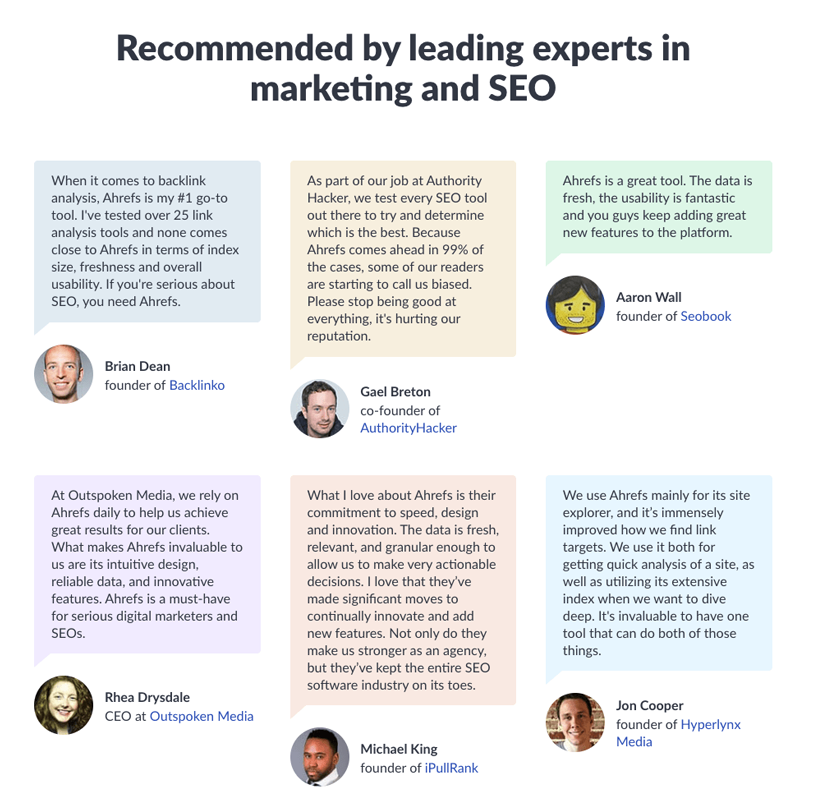
There are several ways that businesses can incorporate testimonials and customer reviews and become effective content marketing strategist. Here are some examples:
- Use testimonials on your website: Adding testimonials from satisfied customers to your website can be a great way to show potential customers that your products or services are effective and well-regarded.
- Share customer reviews on social media: You can also share customer reviews and testimonials on your social media channels to reach a wider audience and build trust with potential customers.
- Use customer stories in your content: Sharing stories of how your products or services have helped your customers can be a powerful way to show the value of your offerings and build brand loyalty.
- Incorporate reviews into email marketing: Including customer reviews and testimonials in your email marketing campaigns can help to increase engagement and drive conversions.
11. Influencer Marketing:
Influencers can be a powerful form of content marketing strategy for businesses, particularly those that target younger demographics who are active on social media.
Influencer marketing involves partnering with social media influencers who have a large following and influence over their audience to promote your brand, products, or services.
Here are some ways that businesses can incorporate influencers into their content marketing strategy:
- Find the right influencers: It’s important to find influencers who align with your brand’s values and target audience. Look for influencers who have significant following, high engagement rates, and who share content related to your industry.
- Collaborate with influencers to create content: Work with influencers to create content that highlights your brand or products. This could include product reviews, sponsored posts, or social media takeovers as to what products are popular right now.
- Host events or giveaways with influencers: Partner with influencers to host events or giveaways that showcase your products or services. This can help to increase brand awareness and drive sales.
- Repurpose influencer content: Repurpose influencer content on your own social media channels or website to maximize its impact and reach a wider audience.
12. Guest blogging:
It is a content marketing strategy that involves creating and publishing blog posts on websites other than your own. It is a way to reach a wider audience, establish authority in your industry, and build relationships with other bloggers and website owners.
Reach out to other bloggers or websites in your industry and offer to write a guest post. This will help you reach a new audience and build backlinks to your website.
- Research and target relevant websites that have a similar audience and align with your brand’s values.
- Pitch your blog post ideas to website owners and editors, and make sure that your content is unique, high-quality, and relevant to their audience.
- Include a brief author bio and a link to your website in your guest post, to help build your brand and drive traffic to your site.
- Engage with the website’s community by responding to comments and sharing your guest post on social media.
13. Webinars:
Webinars can be an effective form of content marketing strategy for several reasons.
- First, they allow businesses to showcase their expertise and knowledge on a specific topic, which can help to build credibility and authority in their industry.
- Second, webinars can be used to generate leads by requiring attendees to provide their contact information before accessing the webinar.
- Third, webinars can provide a more engaging and interactive experience than other forms of content, such as blog posts or whitepapers.
14. Lead Magnets:
They are a type of content marketing strategy that involves offering something of value to your target audience in exchange for their contact information.

Here are some reasons why lead magnets can be an effective content marketing tool:
- Increase Engagement: By offering something of value, such as an e-book, whitepaper, or webinar, you can increase engagement with your target audience and keep them coming back for more.
- Establish Authority: By providing valuable information, you can establish yourself as an authority in your industry, which can help build trust and credibility with your target audience.
- Provide Value: By providing valuable information or resources, you can help solve problems or answer questions that your target audience may have, which can build goodwill and positive brand associations.
Lead magnets vary greatly from one another. While it is possible to rapidly put together a checklist or reading materials, you might not receive the results you were hoping for.
It’s important to take your time and produce content that will be actually helpful to your readers. An effective lead magnet should:
15. Marketing Deck:
Several objectives, both internal and external, may be served by marketing decks. For instance, specific presentations are used internally by marketing and advertising teams.
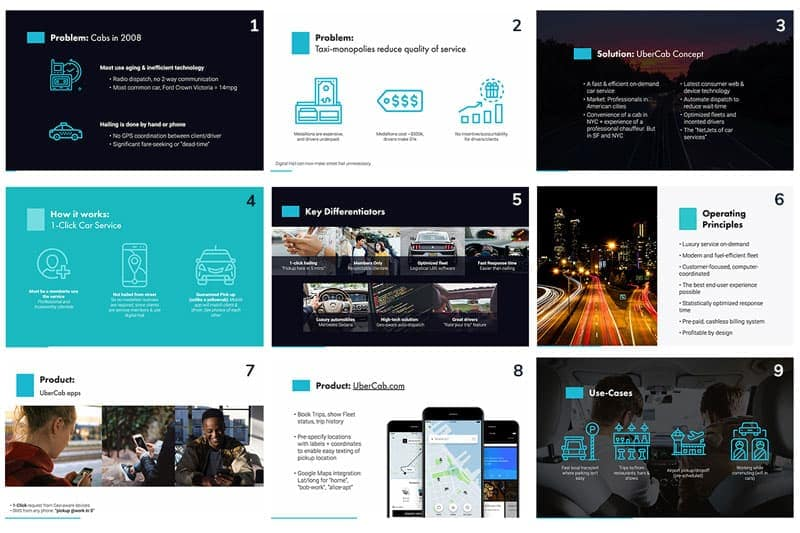
If you take the example of a Pitch Deck – Co-founder of Uber, Garret Camp presented the first slides they produced in late 2008 for the company’s ninth anniversary. Uber began as a small platform known as UberCab and has since grown into a significant platform that has enhanced the car service sector.
They are frequently known as “snapshot decks” and might have statistics and data for a certain time frame.
No matter your business, size, or specialisation, a marketing deck offers the following advantages:
- Potential partners and investors use the information you present to determine whether they want to move further with investing in your company, which usually entails a meeting.
- Also, it aids in describing your company’s operations to potential workers, clients, and consumers.
- It’s a living document that you may update when your company’s requirements and objectives change.
A well-designed marketing deck is a valuable business tool for firms trying to expand, whether through raising more money or bringing onboard new clients and partners.
16. Interviews and Q&A
Through interviews, you may show your customers the human side of your company. Also, customer interviews let them realise what they themselves are capable of.
Being “on the record” demonstrates to the world your support for your proposal. This suggests high-quality customer service, aids in reputation management, and raises user engagement generally.
17. Listicles
Use listicles as part of your content marketing strategy because they are a really powerful post style. Listicles can be used wisely to produce high-ranking content that excites readers and drives significant traffic to your website.

Almost all subject areas and niches can benefit from list postings. List postings make difficult subjects simpler for your readers to understand and can also be read quickly.
- To get started, pick a hot issue or top trending topics in your niche that has enough interest to warrant a list article. Also, you must confirm that list posts are now appearing in search results for the relevant keyword.
- You should take advantage of the fact that list posts are excellent at attracting backlinks and social shares by focusing on as many pertinent keywords as you can.
- To choose the keyword(s) you’ll be targeting with this content, you must first conduct keyword research.
- To make it simpler for visitors to scan your material and for search engine bots to crawl your website, you should optimise your post.
- You can increase website traffic and produce engaging content by producing listicles for your website.
18. User-generated Content
In the modern era, where customers are willing to gush about your goods or services online, user-generated content (UGC) has emerged as a crucial component of the content marketing strategy.

UGC is the term used to describe material produced by customers of a brand. It might be anything, including posts on social media, comments, and reviews.
92% of consumers trust user-generated content more than traditional advertising, according to the Nielsen Consumer Trust Index.
This is so because user-generated content (UGC) is unpaid, unbiased, and produced by customers who like a company’s products. UGC is seen as being more sincere and honest as a result.
19. Whitepapers
A white paper is a persuasive, trustworthy presentation of in-depth knowledge on a particular subject that offers a solution. A clean and precise voice is used to convey the facts.
It increases a brand’s dependability while resolving challenging business issues.
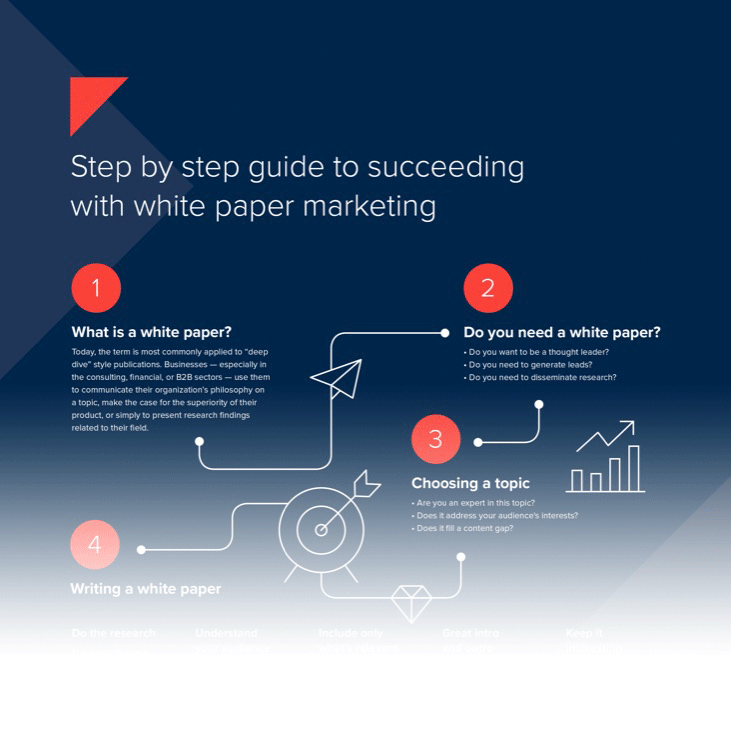
White papers can be a useful tactic for content marketing campaigns targeting businesses. They can also inspire and encourage other companies to work with you by offering in-depth knowledge on a particular topic.
In terms of the level of detail, white papers differ from blog postings.
20. Guides And How-Tos
In-depth guides and how-tos are necessary for any company offering a complex product or service.
More people than ever before have access to information nowadays. That might significantly affect enterprises.
Self-service alternatives that are simple to use and comprehend are what customers choose. An expertly written how-to manual can:
- Encourage inquisitive and irritated clients.
- provide 24-hour assistance
- captivate readers
- consider user requirements
- How-to guides are a great way to introduce high-quality, useful material to new audiences.
- How-to manuals are frequently important for a successful lead generation plan for both B2B and B2C enterprises.
For instance, think about how many people use Google every day to seek “How to…”
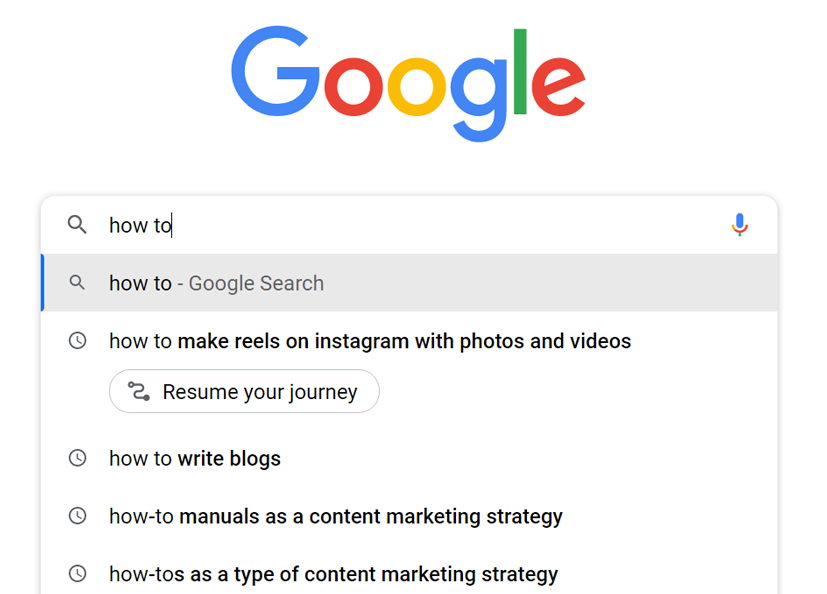
21. Reels
Instagram Reels are a powerful tool for content marketing because they offer a unique and engaging way to reach a wider audience on the platform. Here are some reasons why Instagram Reels are important for content marketing:
- Increased Visibility: Instagram Reels are prominently displayed in the Explore section of the app, making them more discoverable to users who are not already following your account.
- Easy to Create: Instagram Reels are quick and easy to create, requiring only a smartphone camera and a few editing tools.
- Versatile Format: Instagram Reels offer a versatile format that can be used to showcase a wide range of content, from product demonstrations and tutorials to behind-the-scenes glimpses of your business.
- Increased Engagement: Instagram Reels are designed to be highly engaging, with a maximum length of 60 seconds and a range of editing tools that can be used to create eye-catching content.
- Improved Algorithmic Ranking: Instagram’s algorithm is designed to promote engaging and high-quality content, and Instagram Reels are no exception.
Reels are a powerful tool for expanding your audience beyond your present fan base. 50% of Instagram users use the explore page to locate reels. You can highlight videos on the explore page to expose them to a brand-new audience.
Reels receive 22% higher engagement than regular videos, according to current research. These statistics come from NBA teams who have had a lot of success using Instagram reels. Large companies like Nike and Louis Vuitton have also released figures of the same kind.
22. GIFs
Every marketer aspires to make their efforts more appealing and compelling. GIFs are being used by marketers to achieve this goal increasingly frequently.
Why? You can easily add eye-catching animations to your emails, landing sites, blog posts, and more by using GIFs!
GIFs are more visually appealing than static images. They give your material motion and, when used properly, greatly increase its ability to stand out in emails, advertisements, social media feeds, blog posts, and other places.
GIFs offer businesses a fantastic opportunity to showcase their unique brand personas through animated graphics. Several companies have already started doing it. For instance, a short glance at the Pop-Tarts GIPHY channel reveals that this brand is funny and caters to Gen Z consumers
- Display the Character of Your Brand With GIFs
- Display Your Goods With GIFs
- Utilize GIFs to instruct users on how to do something
- Use GIFs to express gratitude to your clients
- Employ GIFS in Advertising
Tools for Measuring Effectiveness
Measuring the effectiveness of your content online is crucial for optimizing your content strategy, demonstrating ROI, and staying ahead of the competition.
It allows you to understand the impact of your content and make data-driven decisions to improve your content marketing efforts.
There are various Content marketing tools that can be used to measure and analyse the effectiveness of content marketing. Here are some of them:
- Google Analytics:
It is a free content marketing tool that helps you track the traffic on your website, including the number of visitors, page views, bounce rates, and time spent on your site. You can use Google Analytics to measure the effectiveness of your content by analysing metrics such as the number of page views, average time on page, and bounce rate.
- Buzzsumo:
It is a content research and monitoring tool that can help you analyze the performance of your content and that of your competitors.
You can use Buzzsumo to track the number of social media shares, backlinks, and overall engagement on your content.
- SEMrush:
It is a content marketing tool that can help you analyze your content’s SEO performance, including keyword rankings, organic search traffic, and backlinks.
You can use SEMrush to identify which of your content is performing well and what changes you can make to improve its performance.
- Ahrefs:
It is another SEO tool that can help you analyze your content’s backlinks, organic search traffic, and keywords.
You can use Ahrefs to identify your top-performing content and optimize your content strategy.
5. Hootsuite:
Hootsuite is a social media management platform that offers a range of analytics tools to help businesses measure the performance of their social media presence. Some of the key features of Hootsuite’s social media analytics tools include:
- Content scheduling: Hootsuite allows you to schedule your social media posts in advance, which can help you maintain a consistent content calendar. You can create a schedule for your posts across various social media platforms, including Facebook, Twitter, Instagram, and LinkedIn. This feature can save you time and help you stay organized.
- Content curation: the content marketing tool also allows you to curate content from other sources and share it on your social media profiles. This can help you provide value to your audience by sharing relevant and interesting content, even if it’s not your own.
- Analytics: it provides analytics that can help you track the performance of your social media content. You can see metrics such as engagement rates, clicks, and conversions, which can help you understand what types of content are resonating with your audience.
Overall, Hootsuite can be a valuable tool for implementing a content marketing strategy on social media. It can help you save time, stay organized, and measure the performance of your content.
